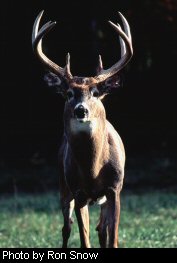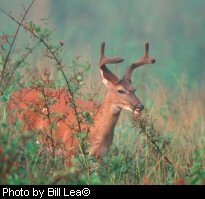

Racking Up The PointsBy Keith D. Krantz
Most does in West Virginia give birth from the end of May through the first weeks of June. The “nubs” or “buttons” on a male fawn's head are the pedicels from which antlers will grow in succeeding years. Unlike cattle or antelope that have horns, deer have antlers that are shed every year. Antler growth is triggered by a change in photoperiod , or day length, as winter turns to spring. As day length increases, the pituitary gland in a buck's brain produces a hormone which stimulates the pedicels to begin growing antlers. Concurrently, the pituitary triggers the testicles to begin producing additional testosterone. At first, antlers are comprised of soft, growing bone surrounded by fur-covered skin called velvet. Interwoven through the velvet is a network of blood vessels that supply calcium, phosphorous and other minerals needed to make bone. Antlers continue their rapid growth throughout the summer and are susceptible to injury at this time. Injury is a reason some racks exhibit perfect formation on one side while the other is twisted or malformed. Some antlers contain holes or have “acorn tips,” which are indicators of injury during development. Injuries to the large leg bones also causes abnormal development in the opposite side antler. Beginning in July, the amount of testosterone in the bloodstream increases again. By late August, increasing levels have caused the antler development to stop. As blood flow ceases, the velvet hardens and begins to fall off. Bucks typically remove the hanging velvet in a day or two by rubbing their antlers on saplings and small trees. By late September the process is complete and the buck has a set of polished antlers that will serve him during the coming breeding season. A pituitary hormone called androgen maintains the point of connection between the living pedicel and the dead antler through early winter. In mid- to late-winter, androgen levels decrease and the connection between pedicel and antler weakens. Eventually, the antler falls off or is knocked off and the buck remains antlerless until the cycle starts again. The most important factors regulating antler size and shape are nutrition, age and genetics. White-tailed deer normally develop their first set of antlers at 1½ years of age. During this time the skeletal and muscular systems grow rapidly. If a buck is malnourished, nutritional energy will be directed towards body growth, not antler production. In some parts of the country, it is not unusual to encounter yearlings and sometimes 2-year-old bucks without antlers because of poor habitat. Conversely, yearling bucks sporting small eight-point racks are common in areas with quality forage. Much has been written in scientific and popular publications about supplemental feeding. Direct feeding of deer should not be practiced because it promotes localized overbrowsing and increases disease transmission. The purpose of augmenting a deer's diet is to provide a high level of protein to promote body growth and ultimately realize their antler potential. Common high protein agricultural crops planted for deer include alfalfa, clover, soybeans and rape. Research suggests that effective plantings should be three acres in size, well distributed, and comprise at least three percent of the managed area. Similar to our tastes, deer prefer some plants over others and selectively eat these “ice cream” plants first. Because deer can overbrowse these food plots, a relatively large area is needed to insure plant survival. On large forested acreage, food plot management becomes time-consuming and expensive, but many biologists believe the result is worth the effort. To a much lesser degree, mineral supplementation (calcium, phosphorous and trace elements, not just sodium) may improve antler development if the soils in the area are mineral deficient. Because conclusive research documenting the benefits of mineral supplements is lacking, hunters should not look to mineral supplements to provide a quick fix. With adequate nutrition, a buck's antlers get larger each year, but do not reach their full potential until 5½ years of age. By the time a buck is 7½ years old, body and rack size may begin to deteriorate. The average buck harvested in West Virginia is 1½ years old, so his “trophy” potential is never realized. Hunters commonly refer to these animals as “scrub racks” which is unfortunate. They are simply teenagers and not fully developed. Yearling bucks typically have forked antlers, although some may have spikes. At An example of age and its impact on antler size may be found in four southern counties of West Virginia. Since 1980, the gun season has been closed and the only legal method of taking deer in Logan, Mingo , McDowell and Wyoming counties is with archery equipment. The resulting reduction in the buck harvest has allowed a greater percentage of bucks to survive into older age classes and reach maturity. This is evidenced by the relatively large number of mature bucks harvested annually from this region. Sixty-eight percent of the 101 registered big bucks taken with a bow in 2001 were from these four counties. Genetics is the final factor governing rack size and shape. Research on captive deer has shown that some antler characteristics, mass for example, are heritable. Through successive breedings , the characteristics of a rack can be traced back to an individual male. While not all males have the genetics to produce a record book set of antlers, most, if allowed to mature, will grow an eight-point rack. West Virginia has few entries in the Boone and Crockett record book and ranks 20th nationally in Pope and Young entries. While this is partly due to habitat and age structure, non-reporting plays a major role. According to the 1999 and 2000 West Virginia Big Buck Registries, 160 bucks harvested with bow met the minimum scores to place them in the book. During that same period however, the Pope and Young Club received only 63 entries from Mountain State hunters. Both Boone and Crockett , and Pope and Young clubs require a $25 registration fee to have a trophy entered in their books. Apparently, many hunters are either unwilling to pay this registration fee or do not need the recognition of seeing their names in these books. The WV DNR annually hosts a big buck contest. Trophy bucks meeting the state minimum Boone and Crockett scores are listed by antler type ( typical or non-typical) and method of harvest (bow or gun). The hunter's name and county of harvest also are included and these results are published annually in the Big Game Bulletin, which is available at Wildlife Resources Section district offices in late April each year. The following table provides a compilation of the best trophy bucks entered in this contest. Regardless of whether the trophy buck you see makes the record book or not, consider that it took proper breeding, excellent nutrition and an uncanny ability to survive four or five hunting seasons to get to that size.
Keith Krantz is a wildlife biologist in Elkins. |
||||||||||||||||||||||||||||||||||||||||||||||||||||||||||||||||||||||||||||||||||||||||||||||||||||
 As a crisp November afternoon comes to a close, dusk settles in and deer begin moving around the archer's tree stand. A small spike and four-point buck feeding nearby suddenly come to full alert as a large 10-point approaches. As the mature buck comes into range, the excited hunter draws his bow. The arrow slips off the rest and clatters to the ground. Left standing, he can only admire the three bucks as they disappear over the ridge. Later that evening, during the retelling of his experience, the hunters question why some bucks have larger antlers than others. A discussion of antler development and what governs their size and shape ensues.
As a crisp November afternoon comes to a close, dusk settles in and deer begin moving around the archer's tree stand. A small spike and four-point buck feeding nearby suddenly come to full alert as a large 10-point approaches. As the mature buck comes into range, the excited hunter draws his bow. The arrow slips off the rest and clatters to the ground. Left standing, he can only admire the three bucks as they disappear over the ridge. Later that evening, during the retelling of his experience, the hunters question why some bucks have larger antlers than others. A discussion of antler development and what governs their size and shape ensues.  one time, spike-antlered yearlings were considered inferior, but current research suggests it may be a function of age and nutrition. Because of years of buck-only hunting, the ratio of males to females in some locales is highly skewed to a preponderance of females. One of the problems this situation creates is that there are not enough males to breed all available females in November. Fawns born of females bred in December are more likely to produce spikes their first year simply because they are one month younger. These bucks, if allowed to mature, typically catch up with their older counterparts by the time they are 3½ years old.
one time, spike-antlered yearlings were considered inferior, but current research suggests it may be a function of age and nutrition. Because of years of buck-only hunting, the ratio of males to females in some locales is highly skewed to a preponderance of females. One of the problems this situation creates is that there are not enough males to breed all available females in November. Fawns born of females bred in December are more likely to produce spikes their first year simply because they are one month younger. These bucks, if allowed to mature, typically catch up with their older counterparts by the time they are 3½ years old.